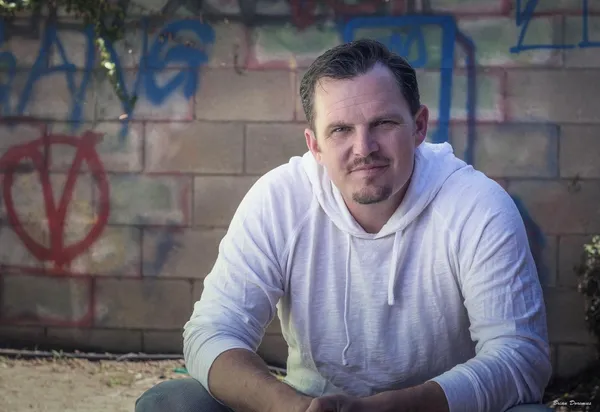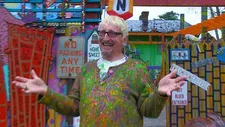 |
| Adam Shell |
What does it take to be a happy person? Could any of us acquire the knack? Pursuing Happiness is a documentary dedicated to finding out. We spoke to director Adam Shell and asked him what inspired him to undertake such an ambitious quest.
“You know, there was a bunch things,” he says. “A few years ago I made a film friend of mine [Nicholas Kraft] who was glutton for joy. He was doing all the stuff you’d expect a teenager to do but he was 45 year old man. It was an eye opener for me. it made me think about the kind of things we do as adults that are acceptable ways to bring fun into life. We had a big response to that film at festivals and people often commented on what a pleasure it was to see a film about joy. I think it’s amazing if one little film has the power to touch people on a level that’s uncanny, and it made me want to do this on a bigger level. Also, today the industry of happiness is so huge, it’s grown exponentially in the last few years. What’s happening now in society is going to make happiness so huge.”
Often documentarians present their films as voyages of discovery when they were actually petty familiar with their subjects to begin with. Adam says that wasn’t the case for him.
“I thought I knew stuff!” he laughs. “There’s this scene in the film where I interview two guys who are authors with a deep knowledge of a lot of the science and they’re quizzing me and – yeah, I had no idea .”
So the film was an educational experience for him too..?
“Absolutely, yeah. There’s a lot that we take for granted. There are things that you don’t realise are within your control... I was speaking to guy, his name is Gary, he’s a life coach, and he said it’s really about how you experience things and react to things. His experience of life, he said, is that what you give is what you get. I said, like karma? He said no, you don’t have to wait for to come back to you. If you put hate out into the world then hate is what you’ll feel, and if you put joy into the world then you’ll feel joyful.”
 |
| Pursuing Happiness |
Did he also learn things from the members of the public whom he interviewed?
“It was about weaving these things together,” he says. “The personal stories work to back up the science and give you real, concrete things you can understand as a human... there’s science that you may understand but there’s no emotional connection so you watch all that and then meet these people and you realise it is that easy, that it’s something you could do too. I got upset at myself the other day and I took a step back and thought, I don’t have to be in this mood. I can change the way I react. I couldn’t change my actual mood but I can change my reactions if I just take a breath and think about the question. I have young kids so it’s really important for me to practice this with them because kids can be trying.”
Does he hope that his kids will learn from his example and from the discoveries he made in the film?
“I’d love for that to be the outcome, but then, my parents did a great job with me, I love my parents, not that they were necessarily up on all stuff that I’m up on, and they didn’t know all this. But I’d like to share with my kids all these little tips, tools and tricks that I’ve learned.”
So the film is about passing on those tricks generally?
“That’s the idea, right? The whole idea with making this film was I wanted to be able to share all this stuff. We spend so much time talking about what’s wrong with the world and not enough talking about things that make us happy. I know more about people getting arrested in my neighbourhood than I do about people doing great stuff and that’s not right. We just don’t pay attention to it. It’s not so exciting as, say, maybe, a shooting”
A shooting might also get more media coverage, I suggest, and he agrees.
“We’re definitely trained by the media and by the entertainment world to seek out certain things. It’s an evolutionary thing that means we react a certain way when see car crash or another kind of tragedy. There’s a reason why you focus on it – it’s a survival instinct. We don’t live in world now where, when you’re walking down the plains and you see a lion eat your friend, you have to watch to make sure the lion doesn’t come and eat you, but we still have those instincts. I have trained myself, with disdain and frustration, not want to watch the news anymore because it’s so full of fear, which is deliberate of course. The more fearful you are, the more you’re going to watch. But we can train ourselves and society to be less afraid.”
On a different note, some of the people we meet during the course of the film are wonderfully eccentric. Is that something he’d say is a characteristic of happy people, or was it just a product of building a compelling storyline?
“Well, any time you’re making an entertainment product you want exciting stories and stuff that pops off the film,” he acknowledges. “The original concept was that I wanted to find the happiest people in the world. So some of it’s exciting and eccentric but that’s not what makes up the entire film. There are a lot of common truths and traits that all the happiest people we met have in common. We wanted to put the spotlight on a lot of normal people too because normal is what we truly relate to.”
Another thing that’s interesting about the film is that it doesn’t deal only with people whose life experiences make it easy to be happy. Gloria, for instance, is seriously ill, and Adam is willing to engage with the tragedy of her situation as he tries to work out why she’s a happy person despite it.
“Originally I didn’t want to make a film about sadness or tragedy,” he says, “but life isn’t all sugar and candy. I was somewhat afraid of that because I didn’t know how to make a film about happiness by talking about sadness, but then it became clear to me that you can’t talk about happiness without talking about sadness and fear. One of the things about Gloria that was so refreshing and beautiful was that she didn’t let that pain or fear enter her psyche and change how she reacted to the world. It was so beautiful to see that because tragedy happens – we can’t live life without experiencing tragedy – but what really matters is how we respond to it... In the third act of the film we ask how do you find happiness in tragedy because one of the key lessons of life is that you can’t always be happy but you always want to be able to get back to that place. The faster you can get from place of sadness to a place of happiness, the better.”
So what else do people need to know about the film?
“The take home message is see the film!” he declares with a laugh. “I say that as a shameless plug, but the aim of film is to share stories and the people I met really did have a profound effect on me and my life. I’d like everybody on the planet to see the film and go out and search out happiness. I did it by making this film. Gloria did it by starting a foundation, and you can do it too. Happiness exists in abundance – it’s out there and it will triumph over everything if we just give it positive attention and energy.”





















